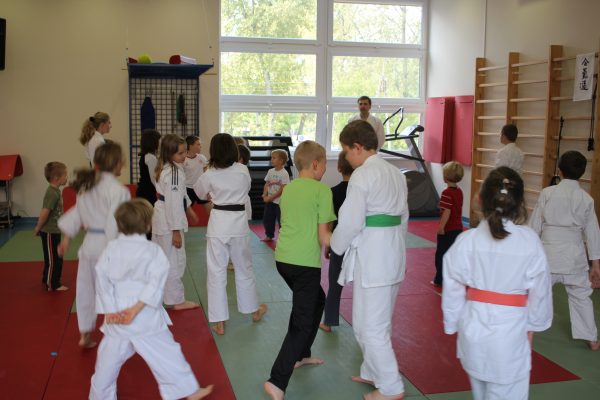 Aikido classes for children have a different character than for adolescents and adults. Aikido is a martial art and suits for defending against physical aggression. Its ethical aspect, which requires dealing with aggression in such a way that both the defender and the attacker will not suffer any physical injury, is also important. The ethical side of aikido is very important in the trainings for children, but its defense aspect is introduced gradually. In the case of the youngest children, aged 6 and a little older, it does not occur at all. Older children are already taught basic defense techniques from the simplest grips. The oldest children, participating in the trainings of a group of children aged 10 and 11, are taught a proper response to the physical threat.
Aikido classes for children have a different character than for adolescents and adults. Aikido is a martial art and suits for defending against physical aggression. Its ethical aspect, which requires dealing with aggression in such a way that both the defender and the attacker will not suffer any physical injury, is also important. The ethical side of aikido is very important in the trainings for children, but its defense aspect is introduced gradually. In the case of the youngest children, aged 6 and a little older, it does not occur at all. Older children are already taught basic defense techniques from the simplest grips. The oldest children, participating in the trainings of a group of children aged 10 and 11, are taught a proper response to the physical threat.
Currently, children are often lacking in physical activity, which is indispensable for proper development. The most important feature characterizing aikido training for children is safety. Children learn to care for it by acquiring greater awareness of their own body, learning how to safely fall over, control their balance, orientation in space and longer concentration, as well as being in a group. The skill of safe exercise, acquired in the initial years of training, allows learning to cope with physical aggression, thanks to the practice of techniques and mental one, thanks to getting used to keep calm in stressful situations. Training includes a warm-up, often in the form of a running game. Then, different ways of moving and breakfalls are practiced. The next element are balance exercises in the form of turning over a partner or defensive techniques. Training is always finished with movement game.
Greater awareness of your own body translates in the future into improved motor coordination, that is, the ability to perform complex movements and switch from one movement exercise to another. Good motor coordination depends on innate predispositions and good motor memory, but also on experience or regular exercise. Aikido provides repetitive sets of exercises regarding movement, falling over, and in the long run, performing simple technical forms. The children perform additional and inverted steps, forwards and backwards, with and without pushing, turns in place and rotations on the forward leg with the shift of the backward leg. They perform also forward and backward breakfalls, from kneeling and standing position, with and without shock absorption. They repeat the basic forms of reaction to attack by immobilizing or overturning the attacker.
Skills acquired during aikido training are useful in everyday life. The ability to successfully defend against attack requires many years of training, but the ability to safely fall over can be acquired within a few months. Children learn the right reflexes in a situation of sudden loss of balance, which allows them to avoid being hurt by accidental stumbling or, for example, when they are pushed. Breakfalls are basic component of every training for children, because they have the greatest impact on their safety. They also enable further development, because the later learning of defense techniques requires knowledge of breakfalls.
The necessity to make a breakfall is the result of a loss of balance. The increase in the ability to control it is an important effect of aikido training. Balance is the most important of the senses and no action is possible without it. Problems of children with behavior or learning are often associated with disturbances in the sense of balance. Mastering this sense is possible due to the large amount of movement. Training for children includes a large amount of balance exercises.
Practising aikido requires good orientation in space. Games that diversify children’s training enable teachers to teach them important skills. Ćwiczenie aikido wymaga dobrej orientacji w przestrzeni. All movement games require moving around in space, teach to avoid collision with other children, watch before the start of movement or change its direction.
Training for children is an excellent learning how to function in a group. Children learn through movement proper communication, cooperation, mutual respect, and control over their reactions. Aikido trainings support the development of children in many dimensions: physical, social and emotional. They teach specific skills as well.


